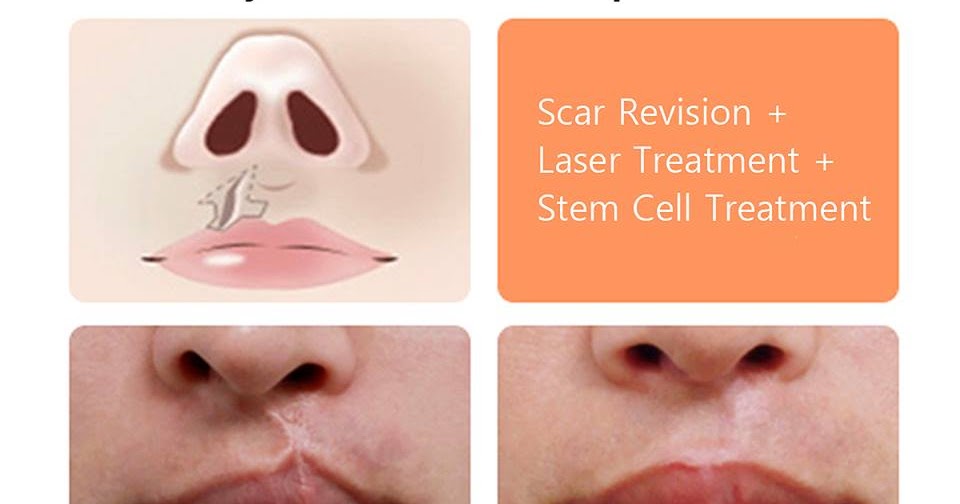Prevent cleft lip
Cleft lip and cleft palate
Cleft lip and cleft palate are birth defects in a baby’s lip and mouth.
Babies and children with cleft lip and cleft palate may have feeding, speech, hearing and dental problems.
We don’t always know what causes cleft lip and palate, but things like smoking, having diabetes and taking certain medicines can increase risk.
Take a multivitamin with folic acid in it each day to help prevent cleft lip and cleft palate in your baby.
Most babies with cleft lip and cleft palate can have surgery early in life to repair cleft lip and palate.
What are cleft lip and cleft palate?
Cleft lip is a birth defect in which a baby’s upper lip doesn’t form completely and has an opening in it. Cleft palate is a birth defect in which a baby’s palate (roof of the mouth) doesn’t form completely and has an opening in it. These birth defects are called oral clefts or orofacial clefts. Birth defects are health conditions that are present at birth. They change the shape or function of one or more parts of the body. Birth defects can cause problems in overall health, how the body develops or how the body works.
Cleft lip and cleft palate are common birth defects. In the United States:
- About 1 in every 1,600 babies is born with cleft lip and cleft palate
- About 1 in every 2,800 babies is born with cleft lip without cleft palate
- About 1 in every 1,700 babies is born with cleft palate
Cleft lip and cleft palate happen very early in pregnancy. Your baby’s lips form between 4 and 7 weeks of pregnancy, and the palate forms between 6 and 9 weeks of pregnancy. Oral clefts don’t have to happen together—a baby can have one without the other. Boys are twice as likely as girls to have cleft lip with or without cleft palate. Girls are more likely than boys to have cleft palate without cleft lip.
How do cleft lip and cleft palate affect a baby’s face?
Some babies with a cleft lip have just a small notch in the upper lip.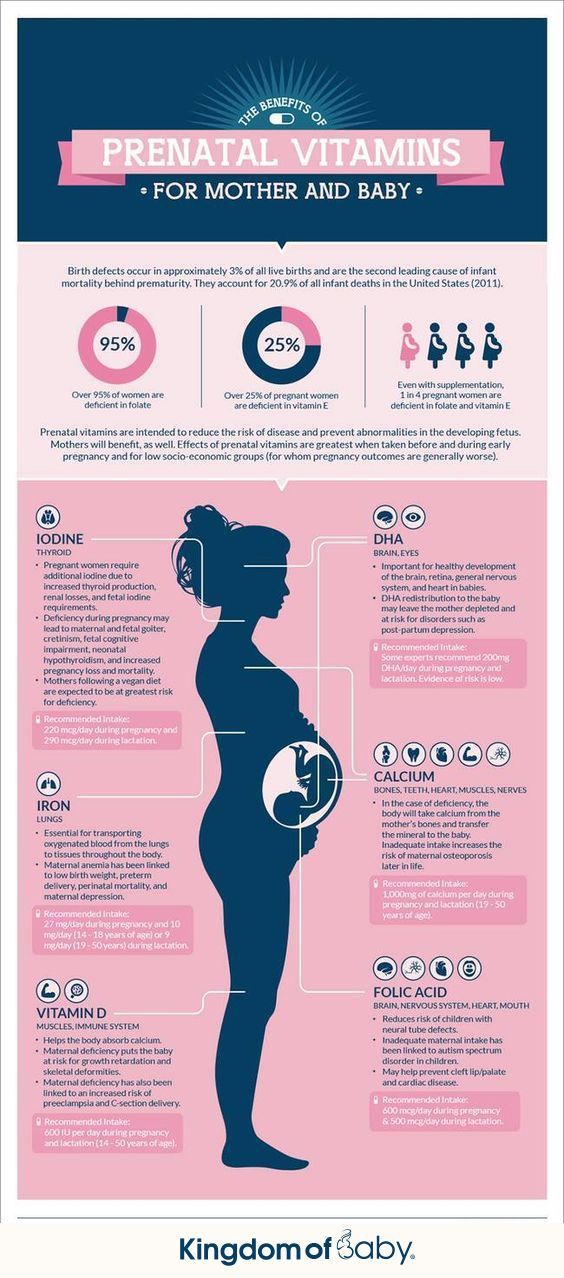 Others have a larger opening or hole in the lip that goes through the lip and up into the nose. A cleft lip can happen on one or both sides of a baby’s lip. Having a cleft in the middle of the lip is rare.
Others have a larger opening or hole in the lip that goes through the lip and up into the nose. A cleft lip can happen on one or both sides of a baby’s lip. Having a cleft in the middle of the lip is rare.
A cleft palate can affect the soft palate (the soft tissue at the back of the roof of the mouth) or the hard palate (the bony front part of the roof of the mouth). In some babies with cleft palate, both the front and back parts of the palate are open. In other babies, only part of the palate is open.
What causes cleft lip and cleft palate?
We don’t know for sure what causes cleft lip and palate. They may be caused by a combination of things, like genes and things in your environment, like what you eat or drink and medicines you take. Genes are parts of your body’s cells that store instructions for the way your body grows and works. Genes are passed from parents to children.
These things may increase your chances of having a baby with cleft lip or palate:
- Family history of cleft lip and cleft palate.
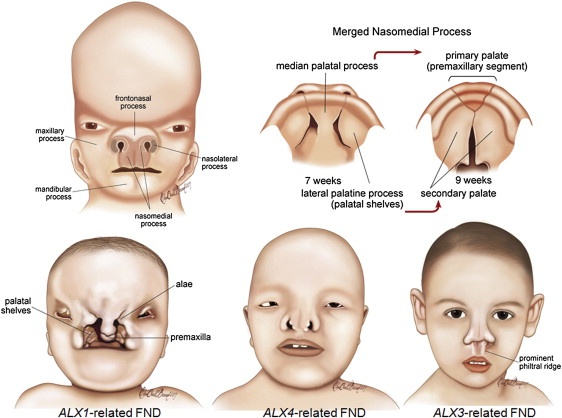 Family history is health conditions and treatments that you, your partner and everyone in your families. If others in your or your partner’s family have cleft lip or cleft palate (they run in your family), you’re more likely to have a baby with these birth defects. Cleft lip and cleft palate are more common in families who are Asian, Hispanic and Native American. If you have a family history of cleft lip or palate, tell your health care provider and a genetic counselor. This is a person trained to help you understand about genes, birth defects and other medical conditions that run in families, and how they can affect your health and your baby’s health.
Family history is health conditions and treatments that you, your partner and everyone in your families. If others in your or your partner’s family have cleft lip or cleft palate (they run in your family), you’re more likely to have a baby with these birth defects. Cleft lip and cleft palate are more common in families who are Asian, Hispanic and Native American. If you have a family history of cleft lip or palate, tell your health care provider and a genetic counselor. This is a person trained to help you understand about genes, birth defects and other medical conditions that run in families, and how they can affect your health and your baby’s health. - Smoking or drinking alcohol during pregnancy. Women who binge drink during the first weeks of pregnancy are more likely to have a baby with a cleft lip or cleft palate than other women. Binge drinking is when you drink four or more drinks in 2 to 3 hours.
- Not getting enough nutrients, like folic acid, before and during pregnancy.
 Folic acid is a vitamin that every cell in your body needs for healthy growth and development. If you take folic acid before pregnancy and during early pregnancy, it can help protect your baby from cleft lip and palate and birth defects of the brain and spine called neural tube defects.
Folic acid is a vitamin that every cell in your body needs for healthy growth and development. If you take folic acid before pregnancy and during early pregnancy, it can help protect your baby from cleft lip and palate and birth defects of the brain and spine called neural tube defects. - Having diabetes before pregnancy. Diabetes is a condition in which your body has too much sugar (called glucose) in the blood. Diabetes before pregnancy is also called preexisting diabetes or type 1 or type 2 diabetes.
- Taking certain medicines during pregnancy. If you have epilepsy and take anti-seizure medicines (like topiramate or valproic acid) during the first trimester of pregnancy, you’re more likely to have a baby with cleft lip (with or without cleft palate) than women who don’t take these medicines. Epilepsy is a seizure disorder that affects how the nerve cells in your brain work. A seizure is when the whole body or parts of the body move without control.

- Being affected by obesity during pregnancy. If you’re obese, you have an excess amount of body fat and your body mass index (also called BMI) is 30 or higher.
What can you do to help prevent cleft lip and cleft palate in your baby?
You can’t always prevent cleft lip and cleft palate in your baby. But there are things you can do to help reduce your baby’s chances of having these birth defects:
- Take folic acid. Before pregnancy, take a multivitamin with 400 micrograms of folic acid in it every day. During pregnancy, take a prenatal vitamin with 600 micrograms of folic acid in it every day.
- Don’t smoke or drink alcohol. Alcohol includes beer, wine and liquor.
- Get a preconception checkup. This is a medical checkup you get before pregnancy to help make sure you’re healthy when you get pregnant.
- Get to a healthy weight before pregnancy and talk to your provider about gaining a healthy amount of weight during pregnancy.
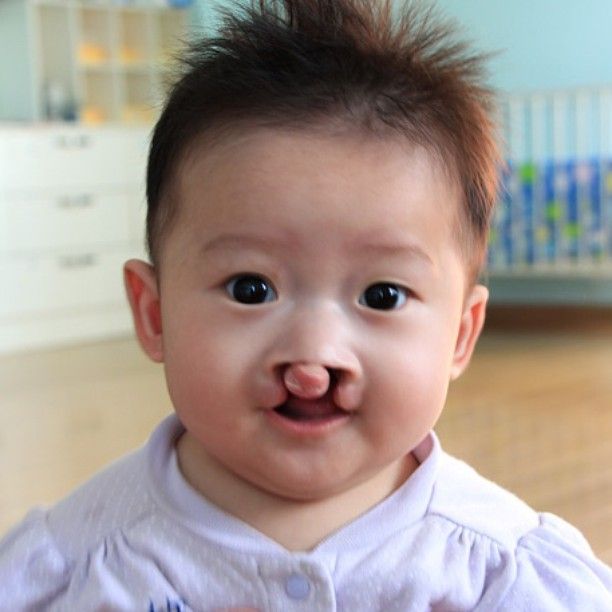
- Talk to your provider to make sure any medicine you take is safe during pregnancy. You may need to stop taking a medicine or switch to one that’s safer during pregnancy. Don’t stop taking any medicine without talking to your provider first.
- When you do get pregnant, get early and regular prenatal care. Prenatal care is medical care you get during pregnancy.
How are cleft lip and cleft palate diagnosed?
Most babies are diagnosed with cleft lip or cleft palate after birth. Some babies with certain types of cleft palate may not be diagnosed until later in life. But during pregnancy, your provider may see your baby’s cleft lip or palate in an ultrasound. Ultrasound is a prenatal test that uses sound waves and a computer screen to show a picture of your baby inside the womb.
What problems can cleft lip and cleft palate cause for your baby?
Babies and children with cleft lip or cleft palate may have:
- Dental problems
- Ear infections and hearing problems
- Feeding problems
- Speech problems
If your baby has either, or both of these conditions, it may be more difficult to breastfeed.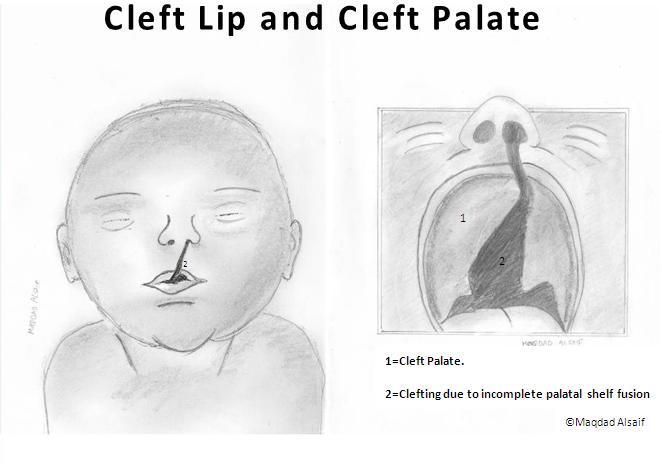 Babies with a cleft lip may need some extra time to get started with breastfeeding. Babies with a cleft palate have more trouble sucking and swallowing so they most likely can’t feed from the breast. However, you can still feed your baby pumped breast milk from a bottle.
Babies with a cleft lip may need some extra time to get started with breastfeeding. Babies with a cleft palate have more trouble sucking and swallowing so they most likely can’t feed from the breast. However, you can still feed your baby pumped breast milk from a bottle.
Your baby’s provider can also help start good breastfeeding habits after your baby is born. There are special bottles that make feeding a baby with cleft palate breast milk from a bottle easier. Your provider may also recommend a lactation consultant and other breastfeeding tips for babies with cleft lip and cleft palate. A lactation consultant is a person that has special training to help women breastfeed. You can find a lactation consultant through your health care provider or your hospital.
How are cleft lip and cleft palate treated?
In most cases, your baby can have surgery to repair oral clefts. Each baby is different, but it’s usually best if a baby has surgery for cleft lip before they’re 1 year old and surgery for cleft palate by the time they’re 18 months old.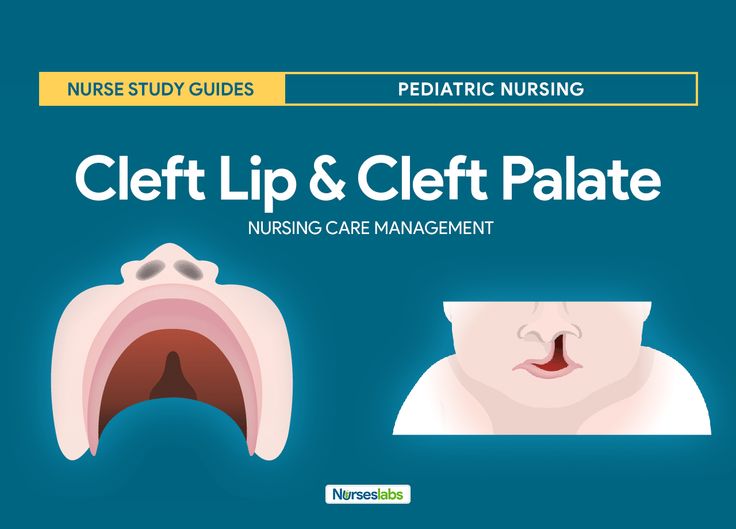 Surgery can help improve the look of a child’s face, and it may help with breathing, hearing and speech and language development. Many children need more surgeries for oral clefts as they grow. They also may need care from several providers, like dentists, doctors, speech therapists and surgeons who specialize in taking care of babies with problems caused by cleft lip and palate.
Surgery can help improve the look of a child’s face, and it may help with breathing, hearing and speech and language development. Many children need more surgeries for oral clefts as they grow. They also may need care from several providers, like dentists, doctors, speech therapists and surgeons who specialize in taking care of babies with problems caused by cleft lip and palate.
With treatment, most children with clefts do well and lead a healthy life. Providers can help babies born with birth defects like cleft lip or palate get the care they need as they grow up and over the course of their life.
More information
American Cleft Palate-Craniofacial Association
Last reviewed March 2022
What it Is and How to Prevent It -
Cleft Lip and Palate: What it Is and How to Prevent It
Posted On: October 22, 2021 By Nathan D. Fox, MD
What is Cleft Lip and Cleft Palate?
A cleft lip or cleft palate happens when your baby’s upper lip and mouth doesn’t form completely.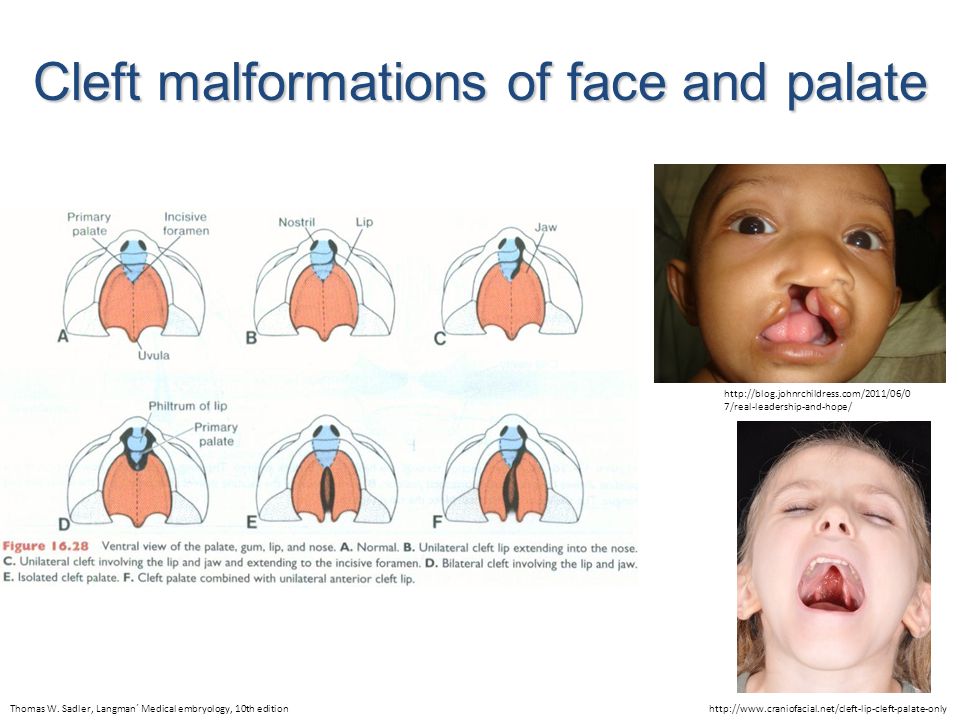 This results in an opening and is present at birth. Oral clefts (or orofacial clefts) occur in about 1 in 1,000 babies in the United States, meaning it’s a relatively common birth defect. It often happens early in pregnancy, or between 4 and 9 weeks of gestation, and male babies are more likely to have a cleft lip (with or without a cleft palate) than female babies, but female babies are more likely to have a cleft palate without a cleft lip.
This results in an opening and is present at birth. Oral clefts (or orofacial clefts) occur in about 1 in 1,000 babies in the United States, meaning it’s a relatively common birth defect. It often happens early in pregnancy, or between 4 and 9 weeks of gestation, and male babies are more likely to have a cleft lip (with or without a cleft palate) than female babies, but female babies are more likely to have a cleft palate without a cleft lip.
Oral clefts can range from mild to severe. In the case of a cleft lip, it can occur as a small notch above the upper lip. Other times, it can occur as a large opening or hole between the upper lip and nose. It most often occurs on one or both sides of the lip. On the other hand, cleft palates can affect either the soft palate (the soft tissue at the back of the mouth) or hard palate (the bony part in the front of the mouth).
What causes oral clefts?
It’s not well understood what causes oral clefts, although there are some things that seem to increase the risk. This usually includes genetic and environmental factors. These include:
This usually includes genetic and environmental factors. These include:
- A family history of oral clefts. Oral clefts can be more common in families of Asian, Hispanic, and Native American descent
- Substance use during pregnancy
- Nutrient deficiency, specifically of folic acid
- Having diabetes before pregnancy
- Use of certain anti-seizure medications
- Obesity during pregnancy
- Certain infections like rubella
During gestation, fetuses develop the skull and face from either side, meeting in the middle eventually. When this process is interrupted at any stage, the face might not fully “close” around the new tissues. As mentioned, this can affect the lip, hard palate, and soft palate based on multiple factors.
What an Oral Cleft Means For Your Baby
Having a cleft palate or lip can result in complications beyond the physical appearance, including:
- Ear infections
- Difficulty with hearing
- Difficulty with speech
- Difficulty feeding
- Dental issues
These wide-ranging consequences require a diverse team of experts who specialize in treating babies born with a cleft palate.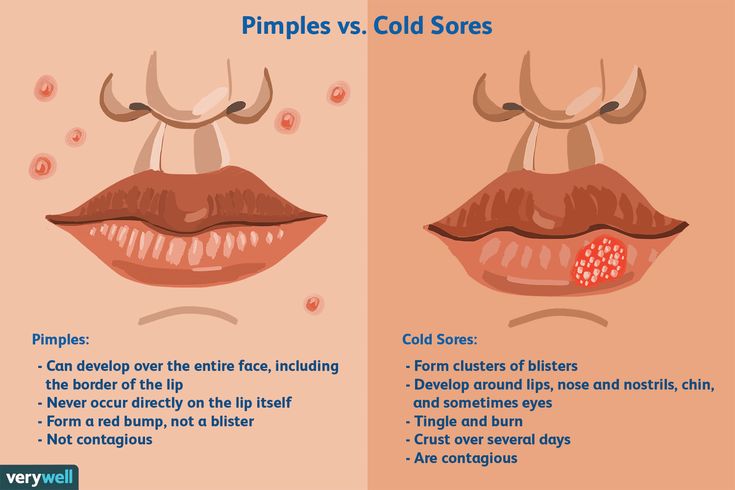
How are oral clefts diagnosed and treated?
Oral clefts can be easily diagnosed after birth and they often can be diagnosed prenatally with ultrasound, but not always. After birth, it’s usually recommended to have corrective surgery performed within one year. This allows for normal growth and development, as well as the prevention of difficulties with breathing, speech, and feeding. It’s possible that your child might need additional surgeries for oral clefts as they grow, so it’s important to partner with a team of dentists, facial surgeons, and speech therapists who can ensure your child develops normally throughout life.
How can I prevent oral clefts?
Although oral clefts are typically not preventable, it makes sense to take folic acid starting prior to conception (at least 400 micrograms per day) and try to avoid alcohol and smoking in pregnancy. Achieving a healthy weight prior to pregnancy can have numerous benefits.
How to Cope With A Birth Defect
Because cleft palate and lip can affect anyone, it often causes significant distress to new parents when they discover their baby has a birth defect they couldn’t prevent. Even though there are treatment options available to correct this condition, that doesn’t mean that it’s not upsetting to get this news, whether during pregnancy or after birth.
Even though there are treatment options available to correct this condition, that doesn’t mean that it’s not upsetting to get this news, whether during pregnancy or after birth.
When you find out about your baby’s birth defect, perhaps the most important thing to keep in mind is that it’s not your fault. This condition can happen regardless of the choices you make, even if you’ve followed your doctors’ every word of advice. The next step to take is finding support from friends and loved ones, reaching out for support.
When it comes to caring for your baby, focus on their personhood. Get them the treatment they need to prevent future complications, and if a long-term side effect stays with them until they’re older, make sure to instill confidence in their appearance and encourage behaviors like smiling and carrying themselves with dignity. It’s also good to keep communication open and non-judgmental so your child will always feel safe coming to you to talk about issues related to their condition in the long run.
Schedule an Appointment
Although oral clefts are not often severe, they can prevent challenges to your child early on. To partner with our expert team and begin taking the right steps for prevention and management of oral clefts, contact our New York City office by calling or filling out our online form.
Carnegie Imaging for Women blogs are intended for educational purposes only and do not replace certified professional care. Medical conditions vary and change frequently. Please ask your doctor any questions you may have regarding your condition to receive a proper diagnosis or risk analysis. Thank you!
Answers to frequently asked questions
The page is being updated. The material is taken from the old site. We will correct and update it soon.
What is a cleft lip and/or palate?
A cleft is an opening in the lip, upper palate, or soft tissue at the back of the mouth. A cleft lip may be accompanied by a hole in the bone of the upper jaw or upper gum.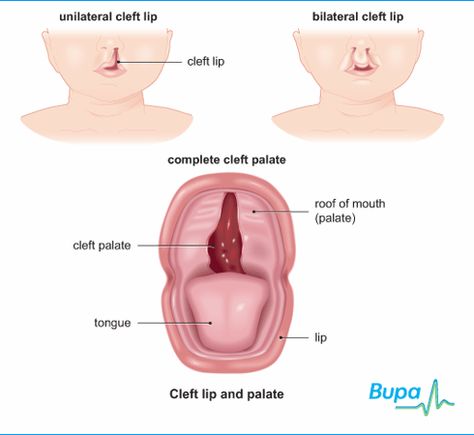 A cleft palate occurs when the two sides of the palate do not meet and leave a hole in the top of the mouth. nine0005
A cleft palate occurs when the two sides of the palate do not meet and leave a hole in the top of the mouth. nine0005
Cleft lip/palate can occur on one side (unilateral) or on both sides (bilateral). A child may have a cleft lip, palate, or a combined cleft lip and palate.
When does a cleft develop?
Cleft lip or palate is a congenital defect that occurs early in the development of the embryo. If during the formation of the facial structure, the tissues of the lip or the bones of the palate do not connect correctly, a cleft may form. As a rule, this occurs at the 4-6th week of pregnancy. nine0005
Why does a cleft occur?
Exact cause unknown. Scientists believe that a number of factors lead to nonclosure, including heredity, ecology, drugs taken by parents; infections and diseases that they have suffered; smoking and drinking during pregnancy; and malnutrition.
If one child in the family has a cleft, the risk of cleft in future children increases.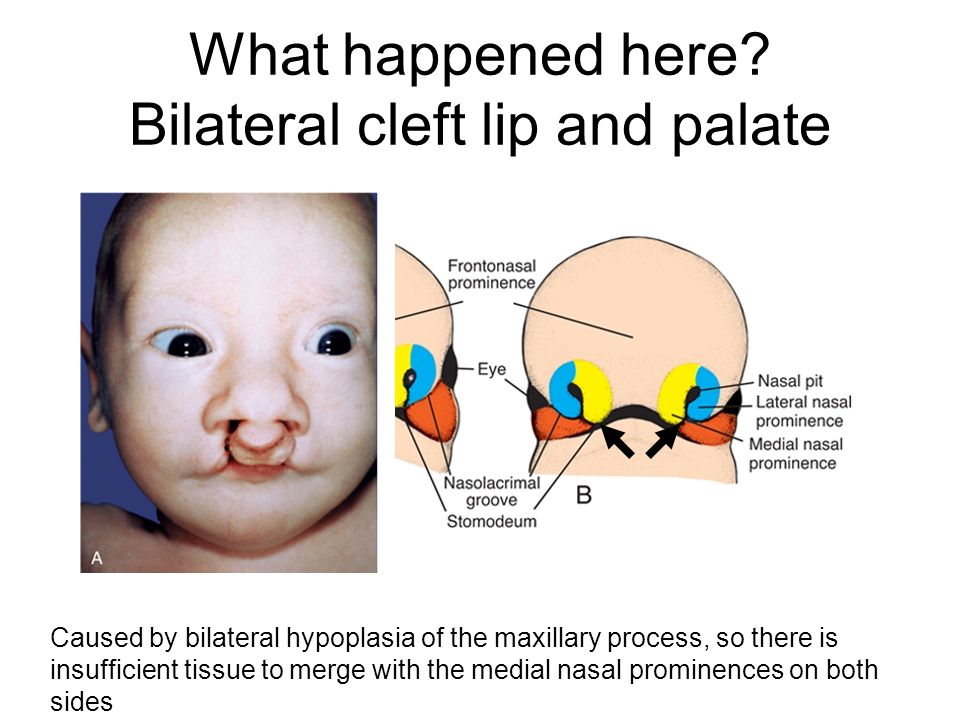
How common is cleft lip and palate? nine0008
According to statistics, one child with a cleft is born in about 800-1000 newborns. According to world statistics, boys are more prone to such defects than girls.
How does a cleft affect a child's development?
Children with clefts often develop ear problems, problems with teeth and speech development, and may also have trouble eating. To solve these problems, parents and the child must work with a team of specialists: a pediatrician, a plastic surgeon, a dentist, an otolaryngologist-audiologist, a speech therapist, a geneticist. nine0005
The presence of a cleft lip or palate does not affect the intellectual development of the child.
Can a cleft be prevented?
Scientists are investigating ways to prevent cleft lip and palate, but data is scarce. According to recent studies, women who take a multivitamin with folic acid before conception and during the first two months of pregnancy may thereby reduce the risk of having a baby with a cleft.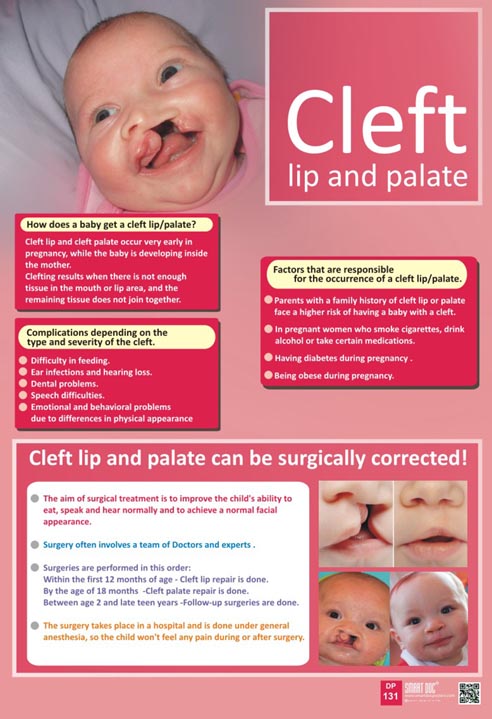 Scientists have also found that smoking during pregnancy increases the risk of developing a cleft in a child. According to other studies, excessive doses of vitamin A may play a role in the development of clefts.
Scientists have also found that smoking during pregnancy increases the risk of developing a cleft in a child. According to other studies, excessive doses of vitamin A may play a role in the development of clefts.
Can the cleft be repaired?
The operation brings positive results. The pediatrician and plastic surgeon, together with the child's parents, determine the best time for the operation. Most surgeons agree that it is best to operate on a cleft lip when the baby is 3-6 months old.
Cleft palate is usually operated on at 12–18 months to avoid dehiscence of the mouth and nose as early as possible. Any surgical intervention is determined by the general health of the child and the characteristics of the cleft lip or palate. nine0005
Postoperative care plays an important role in the effectiveness of the operation. The child will need to study with a speech therapist, visit an orthodontist.
How difficult is the operation to close the cleft?
The operation to close the cleft is a common operation.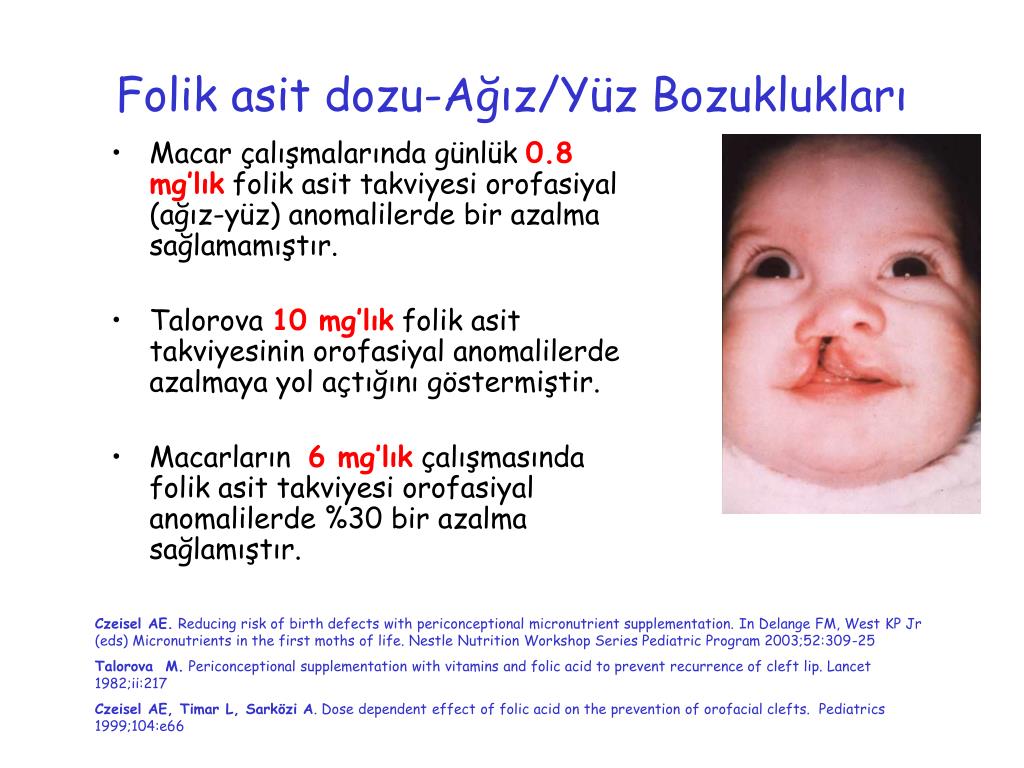 Often this operation is enough to almost completely eliminate the defect. However, phased treatment may be required: for example, to correct defects that appear during the growth process, to eliminate cosmetic defects. In this case, more than one operation is required. nine0013
Often this operation is enough to almost completely eliminate the defect. However, phased treatment may be required: for example, to correct defects that appear during the growth process, to eliminate cosmetic defects. In this case, more than one operation is required. nine0013
What happens if the child does not have surgery?
Children with an unoperated cleft face numerous health problems, including malnutrition, hearing problems (see below), and dental problems.
Children with cleft lip and palate may suffer from ridicule, rejection by society, experience severe psychological stress. This can be avoided if the operation is performed on time and the necessary postoperative care is provided.
See also:
The hare lip and the lion's pascha are one of the most widespread congenital anomalies that affect children in the world. Incomplete molding of the upper lip (opening of the lip) or lower lip (opening of the lower lip) can be repaired, or insulting defects and can be blamed at once. Wash your mind, you can vary over the degree of severity and you can pour into one or the other side of the company. Surgical insertion is necessary for the restoration of the gorge of the lip, or the bottom. nine0005
Wash your mind, you can vary over the degree of severity and you can pour into one or the other side of the company. Surgical insertion is necessary for the restoration of the gorge of the lip, or the bottom. nine0005
Cause and correction
The gap, or the undergrowth of the upper lip, or the lower company, is coming too early in the development of your future child. Under the hour of intrauterine development, the deacons of the upper lip and lower lip cannot grow normally at once. In some cases, the cause of the fault can be a gorge syndrome. For most of the affected children, however, the cause will not be known. In these cases, it is important that the gorge is the result of a complex interplay of genetic and environmental factors. nine0005
Dzherela photo: IDOCTOR.KZ
VIPENNE ROZSHSHILINIA FOR MIDNEBINNNENNENNTSHICHICHI, Yaki Vicoristovoye for the Corrective Significant for the Willed Function of the Baby of the Badge of the Badge of the Badge of the Badge of the Badge of the Bad More cracks can be repaired with the help of special methods in plastic surgery and help improve the health of your child, say, a little and dihati.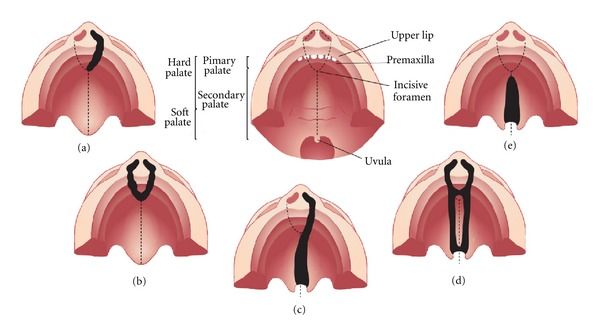
More lower cosmetic correction
Surgical intervention for reopening the lip, or more individually. The operation is indicated to close the gap defect, but also to help your child to function normally and grow. Correction of splitting of the lip, also called cheiloplasty, includes the reconstruction of the lip to make it look more normal, and itself:
- 0112
- Cupid's bow shaping (vinini in the center of the upper lip)
- Establishment of an adequate gap between the upper lip and nose
The clefts of the upper lip swell into the shape of the nose and may be recommended additional procedures:
- Straightening and folding of sufficient fabric for columelli
Oskilki pіdnebіnnya create the bottom of the nasal emptying and vіdpovіdaє for normal language, mіrkuvannya shkodo vіdnovlennya gorіvіnі podnebіnnya include:
- Hem of the fabric of the mouth and nose with a strap covering the defect along the whole length of the life
- Improvement of the soft day function to accommodate normal traffic
- Restoration of the normal opening of the soft ear to the auditory canal and eustachian tube to ensure normal hearing
- Maximum conformity to normal growth and development of the upper jaw and teeth
- Revision, if the number is correct, if there are any defects in the clear, to ensure the post-eruption of the tooth
If my child is to blame if the operation is interrupted?
The terms for the correction of the gorge fall into the individual environment of your child.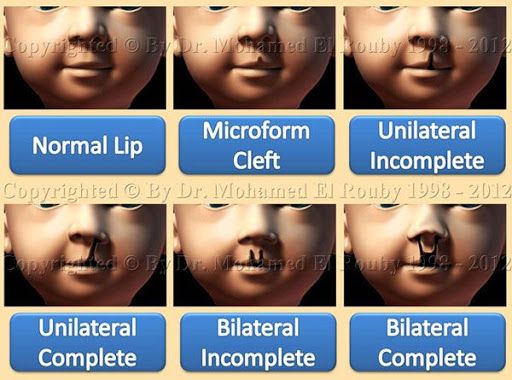
- The correction of the rupture of the ravine will sound at the vіtsі vіd 2 to 6 months in the fallow in the condition of your child's health and mіstsevih protocols in the command of the gorge.
- Correction of the rupture of the lip of the mouth will sound after the correction of the cleft of the lip in an okremіy operation, if the child is 9up to 18 months, in the fall, I will become healthy and my protocols of the team of the gorge.
- Remembrance of the destruction of the ruins or the bottom can be made for the celebration of other, more unsafe problems for life, which may be present, such as the discord of the heart or the legends.
- Fallow in the severity of the gaps can be recommended preoperative insertion, such as a plaster for lips, orthodontic molding (the so-called nasoalveolar molding) or step-by-step surgical methods. nine0112
- Other surgeries may be needed for an hour to cover the cleft, including external tubes for repairing the crown, bone grafting for restoring clearness, and dental or cleft surgery for full malocclusion
Main stages
Krok 1-Anesthesia
Faces are introduced for the safety of your child during the hour of surgical procedures.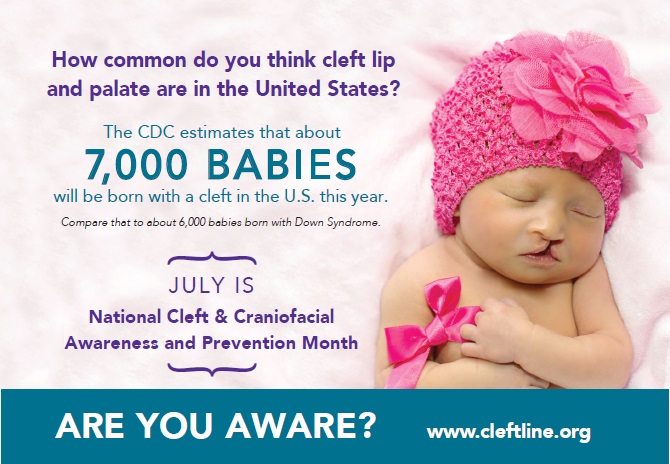 Selection includes internal sedation and general anesthesia. Your doctor will recommend the best choice for your child. nine0005
Selection includes internal sedation and general anesthesia. Your doctor will recommend the best choice for your child. nine0005
Krok 2-Rozrіz
Meta surgery of the lip splitting is important in order to close the lip in the lip and ensure more normal function, structure and normal appearance of the upper lip. Let loose on the offending side of the gorge, to create clappers, m'yazyv and intraoral tissue, as if they are pulled together and stitched together, to close the gorge and create the typical anatomy of the lips and nose.
Remembrance of the sheep's paschi, which will make the strap repositioning of fabrics and m'yazyv, to close the gorge and restore the company. Rozrіzi slablyatsya from both sides of the gorge, and for the repositioning of fabrics of hard and soft pіdnebіnnya vykoristovuyutsya special klaptevі tehnіkі. Tse will include in itself the change of the position of the m'yaziv of the m'yakogo podnebіnnya, which are victorious in the language. Then the plaster is sewn up, as a rule, along the middle line of the day, I will secure enough of the day of the day, so that I can secure a normal meal, the development of the movie and the uninterrupted growth of the long life. nine0005
Then the plaster is sewn up, as a rule, along the middle line of the day, I will secure enough of the day of the day, so that I can secure a normal meal, the development of the movie and the uninterrupted growth of the long life. nine0005
Croc 3-closing rose
Hare lip and bottom line - closed in addition, hare lip or bottom line was confirmed, roses can be closed with roses.
Croc 4-results
Hare lip and lower lip - the resulting scarring of the hare early in the normal contours of the upper lip and nose. In an hour, the stench will appear, and the building of your child will grow and function normally and will continue to grow. nine0005
What am I to blame for the anniversary of the hare's death and the day of my child ?
After the operation, a bandage may be placed on the opening of your child's mouth. You will be given specific instructions for looking after your home, which may include:
- How to look after the surgery after surgery
- Liki, as it is necessary to stop or take it orally, to change the pain, help the infection and reduce the risk of infection nine0111 Special instructions for the year to help protect the place of operation at the hour of closing
- Flooding in eating places or activities necessary for normal feasting
- Specific nutrition for monitoring the health of your child
- If next turn to your plastic surgeon
- Dietary exchanges to expand after the renewal of the day for the help of rare or puree-like diets recommended for a few days.
